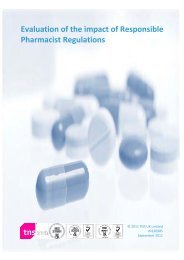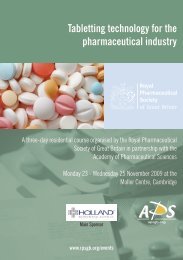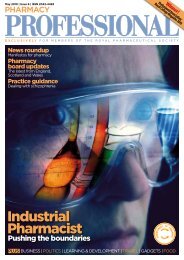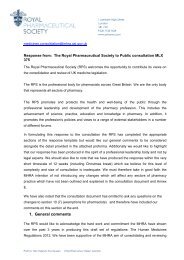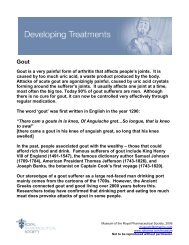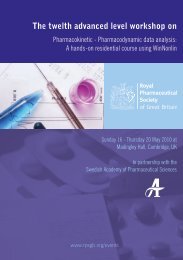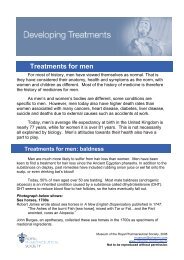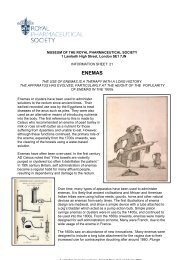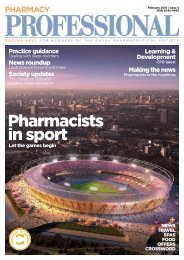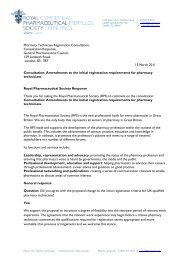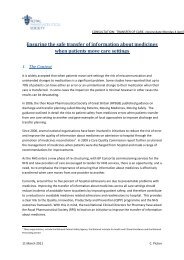RPS Conference 2010, Abstracts 2010 - Royal Pharmaceutical Society
RPS Conference 2010, Abstracts 2010 - Royal Pharmaceutical Society
RPS Conference 2010, Abstracts 2010 - Royal Pharmaceutical Society
You also want an ePaper? Increase the reach of your titles
YUMPU automatically turns print PDFs into web optimized ePapers that Google loves.
62<br />
Deprivation status and utilization of a non-NHS community pharmacy based<br />
cardiovascular risk assessment service<br />
Salah Waheedi 1 , Dai N John 1 , Marc Donovan 3 , Roger Walker 1,2<br />
1 Cardiff University, Cardiff, United Kingdom, 2 Public Health Wales, Cardiff, United Kingdom,<br />
3 Boots, Wales, United Kingdom<br />
Focal Points<br />
• A retrospective analysis of clients who accessed a non-NHS CVD risk assessment service<br />
was undertaken to identify their demographic and socio-economic characteristics.<br />
• Of the 124 service users there were 33 (27%) males, 117 (94%) Caucasians, 43 (35%) from<br />
the least deprived areas and 26 (21%) from the most deprived areas.<br />
• There was no significant difference between the proportions of individuals from the least and<br />
most deprived areas, referred to their GP because of CVD risk<br />
• Different strategies for service delivery and publicity may be required to attract those who are<br />
difficult to engage, such as males and minority ethnic groups.<br />
Introduction<br />
Community pharmacy has an important role in helping tackle health inequalities. 1 A number of<br />
activities have been identified which may contribute to this agenda including the provision of<br />
screening services, particularly if they can reach out to the more deprived sectors of society or<br />
individuals who are more difficult to engage in healthcare. 2 Recent work has indicated that if a<br />
cardiovascular disease (CVD) risk assessment service is provided free of charge, recruitment<br />
across all socio-economic groups can be achieved. 3 Whether a service that requires customer<br />
payment will attract such a broad range of individuals is unknown. The present study was<br />
undertaken to explore this.<br />
Method<br />
A walk-in CVD risk assessment service provided by a large, city centre Boots pharmacy with a<br />
catchment area from across South Wales and beyond was evaluated. Individuals aged 40 to 74<br />
years were eligible and charged £10 to access the service. Data were collected for the period<br />
January 2008 to September 2009 and included demographic characteristics, lifestyle (smoking,<br />
alcohol and exercise), body mass index, waist circumference, systolic blood pressure, blood<br />
glucose, total cholesterol and high density lipoprotein. Advice and referral, if appropriate, was<br />
offered. Residential postcodes for individuals were allocated to one of five deprivation quintiles<br />
(Q1 = least deprived; Q5 = most deprived) using the Townsend Index. 4<br />
Results<br />
A total of 132 adults had their CVD risk assessed and 124 (94%) could be allocated a<br />
deprivation quintile. Of the 124 service users there were 33 (27%) males, 117 (94%)<br />
Caucasians, 43 (35%) from Q1 and 26 (21%) from Q5. Of the others, Q2, Q3 and Q4 accounted<br />
for 13 (11%), 23 (19%) and 19 (15%) respectively. There were no significant differences in<br />
demographic characteristics, lifestyle or test results between Q1 and Q5 except the mean (±<br />
standard deviation) age for Q1 was higher (63 years ±7.1 v 56.9 years ±7.9, p = 0.001 Student’s<br />
unpaired t-test) and the proportion of smokers in Q5 was higher (p = 0.026, Fisher's exact test).<br />
Four of 43 (9%) individuals from Q1 and 5/26 (19%) from Q5 were referred to their GP because



